|
13 Apr
2020 |
SmartResilience final achievements |
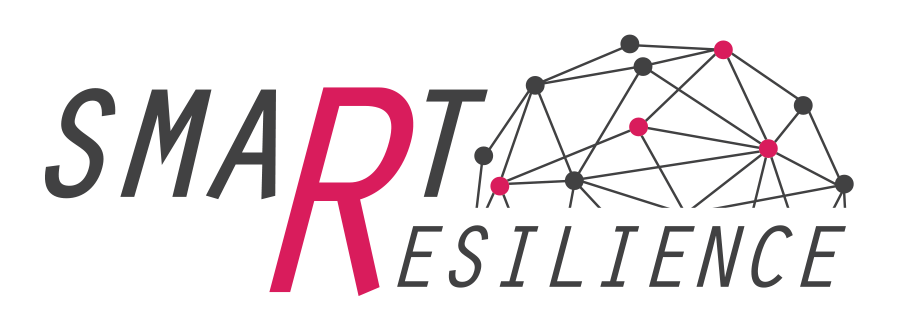 |
The SmartResilience H2020 project, coordinated by EU-VRi, has finished and its main results are released.
|

|
SmartResilience
Smart Resilience Indicators for Smart Critical Infrastructures
|

|
The SmartResilience H2020 project, coordinated by EU-VRi, has finished and its main results are released.
SmartResilience in a nutshell
Modern critical infrastructures are becoming increasingly smarter (e.g. the smart cities). Making the infrastructures smarter usually means making them smarter in the normal operation and use: more adaptive, more intelligent etc. But will these smart critical infrastructures (SCIs) behave smartly and be smartly resilient also when exposed to extreme threats, such as extreme weather disasters or terrorist attacks? If making existing infrastructure smarter is achieved by making it more complex, would it also make it more vulnerable? Would this affect resilience of an SCI as its ability to anticipate, prepare for, adapt and withstand, respond to, and recover? What are the resilience indicators (RIs) which one has to look at?
These are the main questions tackled by the SmartResilience project.
The project answered the above questions in several steps: (1) By identifying existing indicators suitable for assessing resilience of SCIs, (2) By identifying new smart resilience indicators including those from Big Data, (3) By developing, a new advanced resilience assessment methodology based on smart RIs and the resilience indicators cube, including the resilience matrix, (4) By developing the interactive SCI Dashboard tool, and (5) By applying the methodology/tools in 8 case studies, integrated under one virtual, smart-city-like, European case study. The SCIs considered (in 8 European countries!) deal with energy, transportation, health, and water.
Responding to EC Call H2020-DRS-2014-2015: Disaster Resilience: Safeguarding and securing society, including adapting to climate change, the project produced a complete resilience assessment methodology with several accompanying tools, notably the ResilienceTool which supports all of the developed methodology’s features. The methodology and its tools’ good reception made it clear to the consortium that the tool should and could be developed further which actually drove it from the promised RTL4 level (validation in lab) to a fully operational tool at TRL7 (operational prototype) with several real-world cases already implemented within.
Additionally, later in the project, the consortium identified an opportunity to drive the project’s results’ dissemination further and created the new work package (WP9): Ensuring uptake and sustainability of project results which would form the basis for the development of the European Risk and Resilience Assessment agency (ERRA) and that will see the embedding of the project’s results in the new ISO standard 31050: Guidance for managing emerging risks to enhance resilience.
For more information regarding the ResilienceTool, a full user guide is publically available as deliverable D3.7: “The ResilienceTool” of the SmartResilience project on the SmartResilience project’s website.
Main results
The European project SmartResilience has yielded five major break-through results:
|

|
1. Method:
An innovative state-of-the art concept
enabling quantitative assessment of resilience. The concept aims
combines the advantages of approaches oriented towards the
easy-to-understand communication of the assessments results (such as
“resilience very high” or “resilience level red”) with the advantages of
the in-depth assessment approaches, providing many, but often difficult
to understand results (e.g. detailed textual reports from complex
resilience exercises). This main elements of the indicator-based concept
are the “resilience cube” at the top, and the assessment methodology
allowing to (a) assess resilience in a given moment in time and monitor
it over the time, (b) analyze it during a particular adverse effect
scenario, (c) benchmark it, (d) stress-test it, (e) analyze it in a
system of multiple infrastructures and, last but not least, (f) optimize
it a transparent and intuitive way. The concept is public, presented in
publications and presentation and is being summarized in a book under
preparation with the publisher (Springer).
|
|

|
2. Tool:
The concept is applied within a
web-based system, the main elements of which are the resilience
indicator database (over 4,000 indicators available, over 3,000
indicators and almost 1,000 issues), the web-suite of tools (over
20different, combining those pertinent and developed within
SmartResilience project with the “” external” ones) and repository of
the application cases, the later in itself supporting future analyses. |
|

|
3. Applications:
The concept has been practically
applied in 19 case studies in which over 300 different resilience
assessments were made, about 30% of those made for the stakeholders
outside the project (e.g. in other DRS EU projects or the institutions
supporting the partners in the projects – e.g. ministries). The concept
has been discussed and agreed with over 50 different organizational
stakeholders, setup at 7 external-to-the-project “MySmartResilience”
sub-sites. |
|

|
4. Standard:
The project results, at the end of the project, are being
embedded into the new ISO 31050 standard currently under development.
|
|

|
5. Beyond-the-project use:
The “life-after-the-project” of the project results will be practically ensured by the dedicated “resilience rating agency”, the creation of which is initiated at the end of the project (ensuring free-of-charge use after the project), and the educational platform running under the umbrella of the site of one of the academic partners in project.
www.erra.eu-vri.eu |
The TRL (technology readiness level) envisaged at the start of the project to be TRL4, has been over-achieved (approx. TRL5-TRL6). The main results of the projects are already used in the follow-up EU projects and other initiatives.
Duration: 36 Months / Partners: 20 / Programme: Research and Innovation Action in H2020 / Budget-EC Grant: approx. 5-9 Million Euro
http://www.smartresilience.eu-vri.eu |
|
|
|
|
|
06 Dec
2019 |
Steinbeis R-Tech Senior Project Manager Prof. Maile publishes new book |
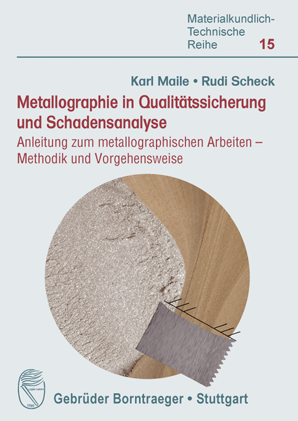 |
Steinbeis R-Tech Senior Project Manager Prof. Dr. Karl Maile, along with Herr Rudi Scheck, have recently published the book Metallographie in Qualitätssicherung und Schadensanalyse (Metallography in quality assurance and damage analysis - see the two-page flyer for more details: Metallographie in Qualitätssicherung und Schadensanalyse - Flyer).
Review the following two-page flyer for more details:
Metallographie in Qualitätssicherung
und Schadensanalyse - Flyer
Metallography in quality assurance and damage analysis
This book provides a brief introduction to materials science and describes the influence of manufacturing and processing on metal microstructure. The location and orientation of samples to produce polished sections from is a critical parameter which affects the conclusions of each and every metallographic analysis. This is where targeted action must be taken to ensure that manufacturing and operational defects in metal components are reliably detected.
Evaluating the acceptability of irregularities in a metal sample requires proper preparation, experience in macroscopic and microscopic evaluation of textures and knowledge of the relevant standards and guidelines. Numerous documentations and case studies exist to provide assistance in the practical procedure. The authors explain characteristic features of different types of defects and suggest optimized procedures or alternative preparation methods.
Assessing damage and material failures is a particularly difficult task for metallographers. The decisive factor for success is the correct analytical approach, the proper choice of the grinding position and its correct orientation. Practical instructions to tackle these task are presented and explained using practical, real life examples. A glossary of relevant terms is presented in the appendix to close gaps in knowledge in the adjacent fields of science, metallurgy and production engineering, so that the instructions for practical work presented in this book can put to use without consulting further literature.
|
|
|
|
|
|
07 Nov
2019 |
Steinbeis R-Tech hosts visiting delegation from Beijing, China |
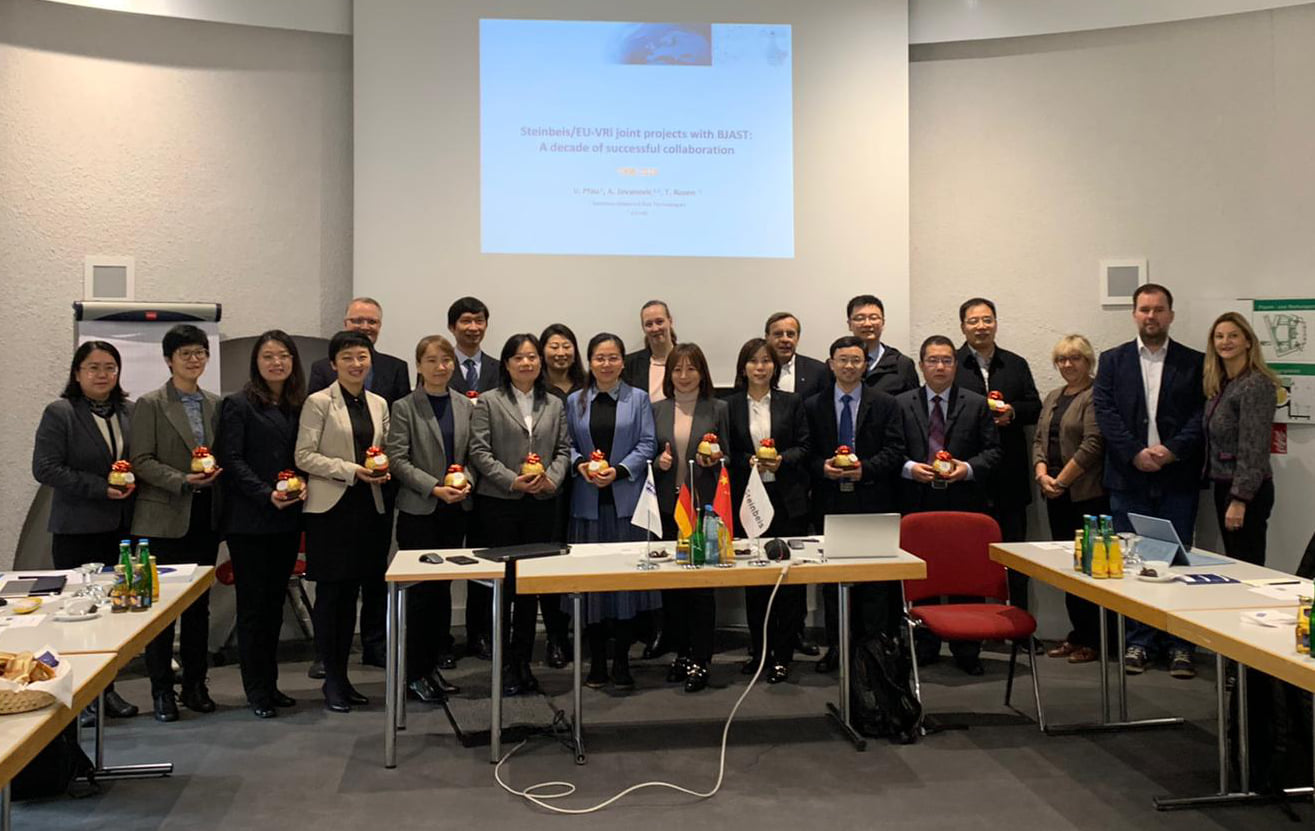 |
On Wednesday, November 6, 2019, Steinbeis Advanced Risk Technologies (R-Tech) had the pleasure of hosting a visiting delegation from Beijing, China, for a meeting in Stuttgart.
Prior to the meeting, the participants spent the preceding week in Cologne, Germany, participating in course on the topics of resilience and smart cities, which was organized by the Steinbeis R-Tech Transfer Institute as part of Steinbeis University Berlin. Over the course of 10 years, the R-Tech group led by Prof. Dr. Aleksandar Jovanovic has worked with the Beijing Academy of Science and Technology on more than 14 strategic projects; this meeting provided a valuable opportunity to reflect on and discuss past, present, and future opportunities for collaboration.

|
|
|
|
|
|
16 Oct
2019 |
A. Jovanovic teaching upcoming course on Risk Based Inspection (RBI) in Amsterdam |
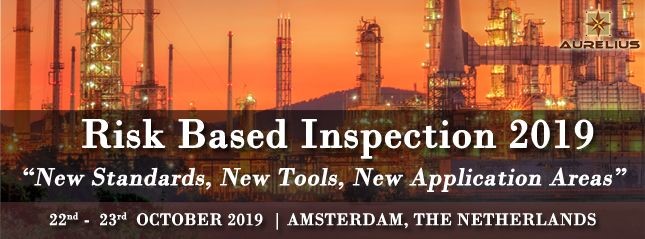 |
Prof. Dr. Aleksandar Jovanović will be leading a MasterClass on RBI from October 22-23, 2019, in Amsterdam, Netherlands.

RBI, as an approach initially developed in and for Oil and Gas Industry has changed a lot in the year 2019. New industrial and international/European standards (such as EN 16991:2018 or new ISO standards, or the less recent API and ASME standards) have been brought into the modern practice. New tools corresponding to these documents and the overall Industry 4.0 trends have been developed, and, last but least; the application area has been broadened to areas such as power and paper industry. Read more about RBI and this upcoming course in the PDF course agenda linked here: RBI 2019 Course Agenda |
|
|
|
|
|
22 Dec
2016 |
Find us on Facebook |
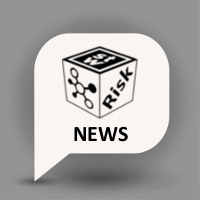 |
If you want to know more about our activities find us on facebook!
Official funpage of Master Study Program - Risk Engineering and Management has been created.
Click on the baner attached hereunder and be the in-thing!

|
|
|
|
|
|
22 Nov
2016 |
Amendments accepted! |
 |
Steinbeis Master Study Program was discussed on November 22, 2016 during 78th Ständige Akkreditierungskommission (SAK) session. SAK is a Accreditation Commission of Central Evaluation and Accreditation Agency (ZeVA). All of the amendments proposed by Steinbeis University were approved. That was the last step in the accreditation process.
|
|
|
|
|
|
16 Mar
2016 |
Masters Degrees Accredited! |
 |
The Steinbeis Transfer Institute Advanced Risk Technologies
successfully accredited three new study programs:
1. Master in Risk Engineering and Management
2. Master in International Business and Risk Engineering
3. Master in Business Administration
|

|
|
The successful accreditation will further enhance the quality of our Master- and Certification Programs and will add value to our high-level courses for all participants, partners and students.
|
|
|
|
|
|
|
|
|
11 Oct
2015 |
ISO 9001 Recertification Audit |
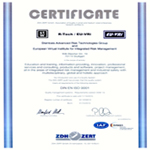 |
In connection that we obtained ISO 9001 certification, the re-certification audit on October 8-9, 2015, showed again that The Steinbeis Advanced Risk Technology Group duly improves the Quality Management System.
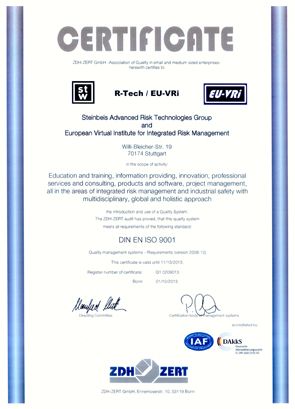 |
|
Steinbeis Advanced Risk Technology Group is one of over one million companies and organizations in over 170 countries where this standard was implemented.
Due to owning this certification, our company stepped to next level of activity with maintaining the highest quality of services which are provided.
|
|
|
|
|
|
|
25 Sep
2015 |
6th International Symposium on Industrial Engineering |
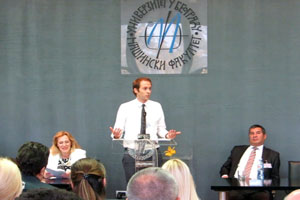 |
Steinbeis Advanced Risk Technologies Group was co-organizer of the 6th International Symposium on Industrial Engineering which took place on September 24-25, 2015 in Belgrade, Serbia.
|
The regular event was hosted by the Mechanical Faculty of the University of Belgrade and co-organized by the Steinbeis Advanced Risk Technologies Group.
The presentation and discussions during and between the different sessions at the SIE 2015 contributed to a better understanding of the important role of Industrial Engineering for an economic and environmental sustainable future of Serbia and other countries. The symposium provided insights into the scientific work and achievements of international researchers as well as interesting trends with respect to the challenges practitioners of the future will have to face.
From the side of Steinbeis Risk Technologies Group, Michael Löscher was invited to give a welcome speech for the opening of the event as well as a keynote on “Safe and Sustainable Innovation in Germany – The Steinbeis Approach”.
|
 |
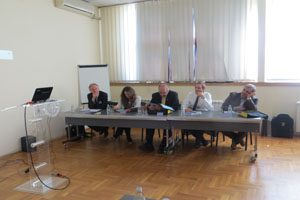 |
|
|
|
|
|
|
18 Sep
2015 |
5th China Europe Risk Forum |
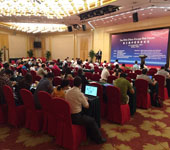 |
On Sept. 16-19, 2015, Beijing Academy of Sciences, European Virtual Institute for Integrated Risk Management (EU-VRi) and Steinbeis Advanced Risk Technologies Group have organized the 5th China Europe Risk Forum. The Forum was devoted to: "Emerging risks and resilience of critical systems and infrastructures".
|
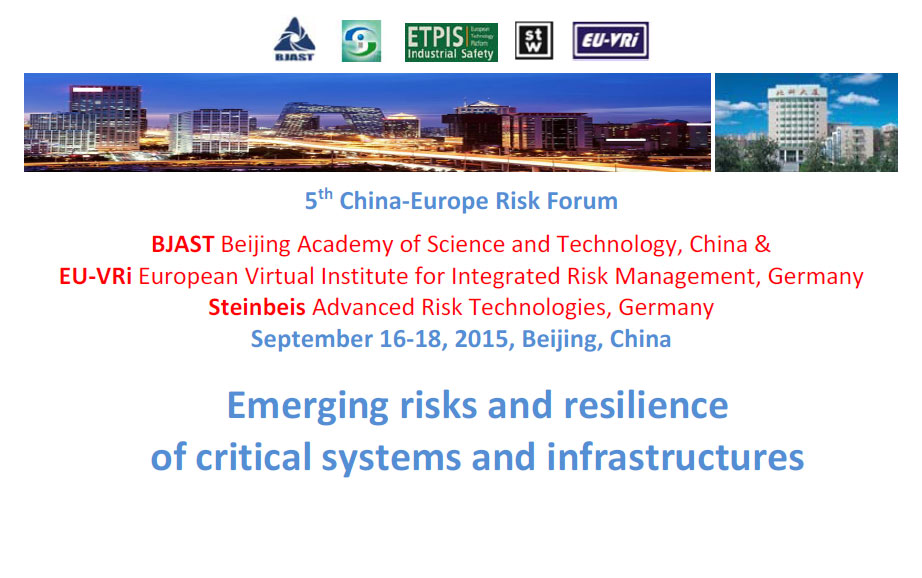
|
| The Forum brought together the specialists in risk fields from different areas and countries from all over the World. The topics were presented by experts, not only from Europe or China, but also by representatives from United States, Singapore and Japan. Thanks to this, it was a very good opportunity to exchange experiences and knowledge, how to deal with hazards which threaten the critical systems and infrastructures. |
|
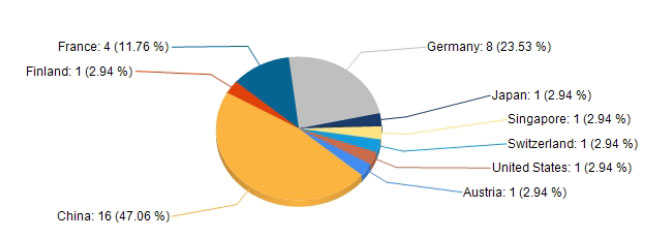
|
|
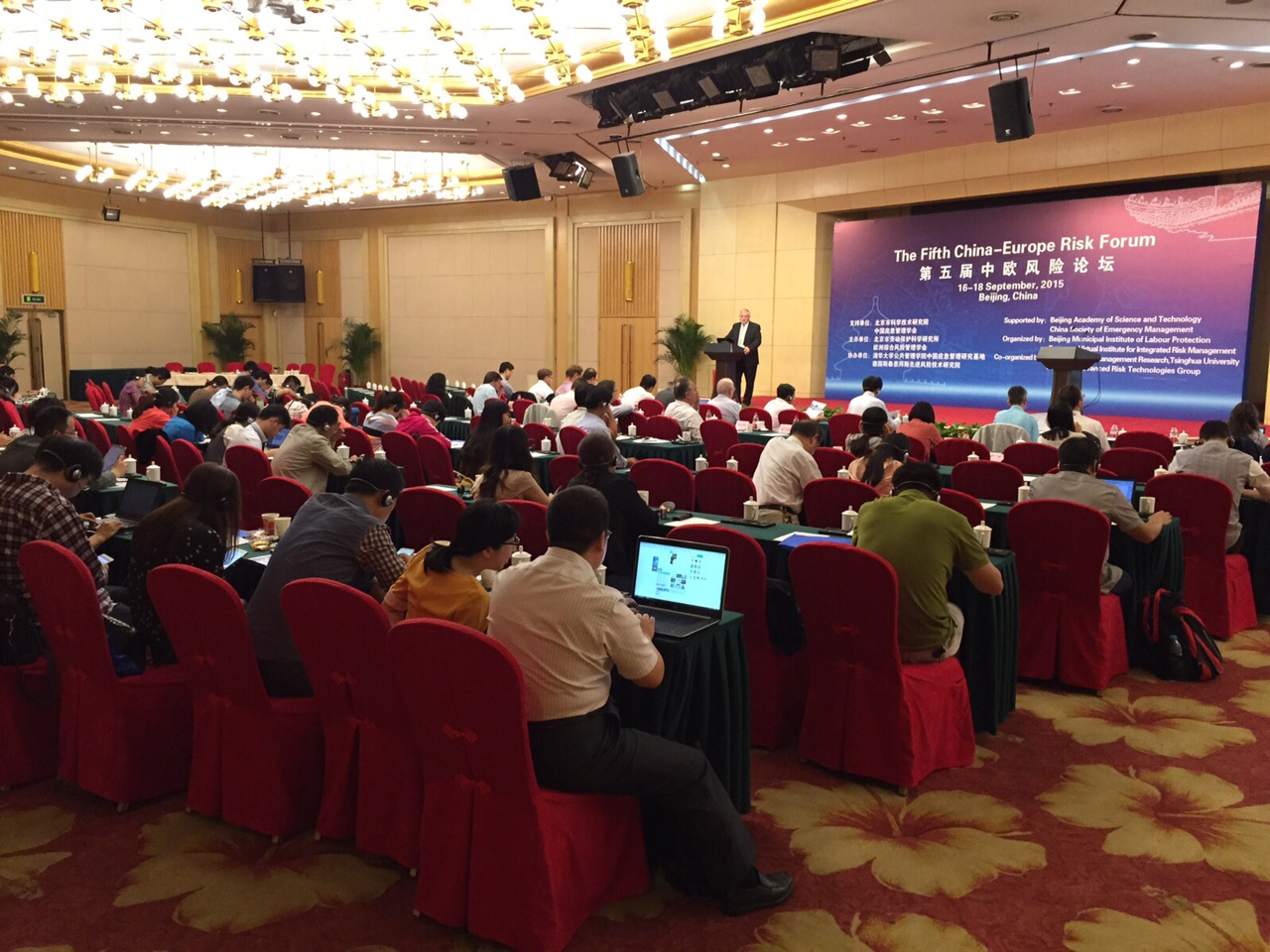
|
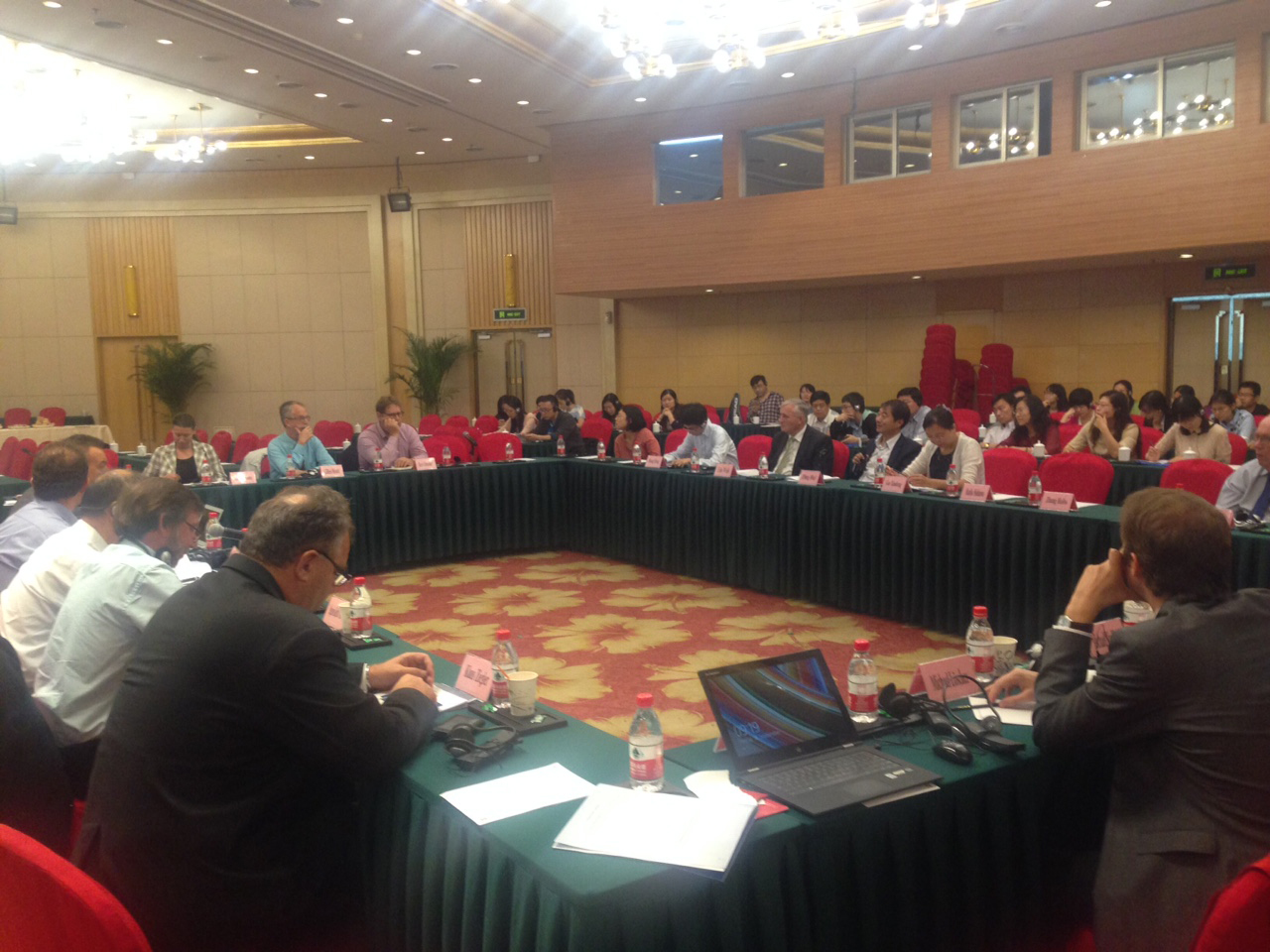
|
|
|
|
|
|
|
24 Jul
2015 |
Risks of Industry 4.0 |
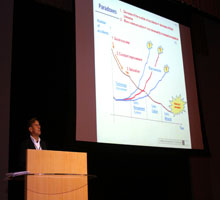 |
Prof. Jovanovic explains the Steinbeis vision and approach in his keynote at The World Congress of Risk in Singapore (July 19-23, 2015)
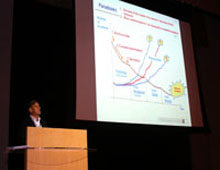
"The overall theme of the 2015 World Congress was Risk Analysis for Sustainable Innovation, highlighting sessions that identified ways that risk analysis can assist private and public policy makers facing complex and uncertain challenges while maintaining innovation and development. Special emphasis was placed on the role of risk analysis as a tool for policy making and tradeoffs in situation of limited resources and extreme challenges that are characteristic of developing countries."*
Among speakers, who represented topics from fields of health, environment, agriculture, engineering, economics, decision-making, psychology, social & political sciences, communication, law & policy, Prof. Jovanovic "(…) explaining his concept of "Industrial Revolution 4.0". He particularly highlighted the difficulties laypeople have in grasping fundamental understandings of where technology is heading today, stating that with the advent of automation, "humans could go the way of the horse", and that the practice of human skills may be lost”**.
The congress is finished, but all new ideas which have arisen during that time will be expanded in the future.
Photos
Read more about The World Congress on Risk 2015
* http://www.sra.org/worldcongress2015
** http://www.sra.org/news/sra-world-congress-risk-2015
|
|
|
|
|
|
01 Jun
2015 |
Risk Perception and Risk Communication June 1 – 3, 2015 |
 |
This course presents theoretical backgrounds and state-of-the-art research issues on perception and communication of risk. It aims to provide a solid basis for further developments of such work tasks by including theoretical achievements in the related fields, various examples from field work, and an internal training exercise. The understanding of communication processes and the improving of information and communication techniques related to risk and hazards are central themes of the course. Information and registration
|
|
|
|
|
|
26 May
2015 |
Safety and Reliability Analysis May 26 – 28, 2015 |
 |
This course presents the basic theory for safety and reliability analysis. Qualitative techniques like functional analysis, FMECA and identification and evaluation of faults and hazards will be introduced. Then quantification techniques like reliability block diagrams, fault- and event tree analysis, and Markov methods will be highlighted. Special attention is paid to safety-critical systems (IEC 61508) where analysis of systems with common cause failures is important. Information and registration
|
|
|
|
|
|
22 May
2015 |
Innovation Risk Management |
 |
The management of innovation is a rigorous process which includes a disciplined, stage-by-stage approval process combined with regular measurement of every critical factor, ranging from the capability of the product to reach the target characteristics to success in the market. In order to help business grow and improve its competitiveness, an integrated design process – described in this course - to achieve a successful innovation is needed. Information and registration
|
|
|
|
|
|
21 May
2015 |
ISO 31010 Principles and Management |
 |
The course provides information as to the selection and application of the risk assessment techniques tackled in the standards and gives examples of application of single methods and techniques.The emphasis of the course is on new and alternative methods (e.g. those expert opinion or big data oriented), which can be used for better identifying the risks and the reason for their occurrence, as well as for better assessing the probabilities and factors determining the consequences. Information and registration |
|
|
|
|
|
20 May
2015 |
ISO 31000 Prinzipien und Management - GERMAN |
 |
Dieser Kurs vermittelt Ihnen Fachwissen über den Internationalen Risikomanagement Standard ISO 31000:2009. Neben der konkreten Anwendbarkeit des Standards in der Industrie und im Allgemeinen, werden Sie lernen, in welchem Verhältnis sich Risikomanagementsprinzipien, Rahmenbedingungen und Prozesse gegenüberstehen. Informationen und Registrierung
|
|
|
|
|
|
19 May
2015 |
ISO 31000 Principles and Management |
 |
The course covers the International Standard of ISO 31000:2009 highlighting the relationship between the risk management principles, framework and process as described in this International Standard. The course also highlights issues related to the applicability of the standard in industry and in general. Information and registration
|
|
|
|
|
|
18 May
2015 |
API RBI Concepts in Industry |
 |
This course is an introduction to the fundamental concepts of Risk Based Inspection (RBI) and it focuses on API RBI methodology. The main topics cover explanations of main elements of the methodology: Probability of Failure, Consequences of Failure, Risk Analysis and Inspection Planning Based on Risk Analysis. Information and registration
|
|
|
|
|
|
11 May
2015 |
Reliability Centred Maintenance and Root Cause Failure Analysis May 11 – 13, 2015 |
 |
Reliability Centered Maintenance (RCM) and Root Cause Failure Analysis (RCFA) are methodologies used for logical decision-making process for analysis and definition of the equipment maintenance requirements, as well as for accident prevention. The focus of the course is on the damage mechanisms appearing in different industries. A large number of well elaborated examples is included. Information and registration
|
|
|
|
|
|
04 May
2015 |
Risk Analysis in Petrochemical Industry May 4 – 7, 2015 |
 |
This course presents current global and regional issues in petrochemical industries. Topics include risk aspects and methods for hazard identification applied in petrochemical industries, probability and consequences analysis, risk assessment and safety and environment issues related to petrochemical industries. Information and registration
|
|
|
|
|
|
29 Mar
2015 |
Business Communication and Management of Intercultural Differences |
 |
The purpose of this course is to highlight the importance of understanding and managing cultural differences for the success of collaboration with partners from other cultural background. It will address issues such as: Intercultural value systems, Differences in cultural practices, Cross-cultural project management, Individualism vs. Teamwork, What one should know, do or not do in an EU project and Case studies: US, Japan, India, China. Information and registration
|
|
|
|
|
|
14 Nov
2014 |
OSHA: Occupational Safety and Health |
 |
In this training course Joachim Freek (Dekra Akademie GmbH Daun) explains the EU regulations in the field of safety and health of workers at work. Main topics include general principles concerning the prevention of occupational risks, the elimination of risk and accident factors, the informing, consultation, balanced participation in accordance with national laws and/or practices and training of workers and their representatives, as well as general guidelines for the implementation of these principles. -›Download the flyer for this event here -›Calender of courses
|
|
|
|
|
|
12 Nov
2014 |
ADR 2013/2015: Transport of Dangerous Materials |
 |
International and EU policies and legislative requirements related to the transport of dangerous materials and the European Agreement concerning the International Carriage of Dangerous Goods will be discussed in this training course. Joachim Freek (Dekra Akademie GmbH Daun) elaborates the main issues from ADR 2013/2015 with its changes as well as safety measures and procedures in case of accidents.
-›Download the flyer for this event here
-›Calender of courses
|
|
|
|
|
|
10 Nov
2014 |
REACH (EG) 1907/2006: Risk Analysis of Chemicals |
 |
In this training course principles of the EU regulation in the area of registration, evaluation and authorization of chemicals – REACH (EC Nr. 1907/2006) are discussed. Joachim Freek (Dekra Akademie GmbH Daun) explains principles and obligations for manufacturers, importers and downstream users to ensure that they manufacture, place on the market or use such substances that do not adversely affect human health or the environment.
-›Download the flyer for this event here
-›Calender of courses |
|
|
|
|
|
20 May
2013 |
Accompanying course to the 5th iNTeg-Risk Conference on the topic of ISO 31000 |
 |
The course 'ISO 31000 Principles and Management' was held just before the 5th iNTeg-Risk Conference 2013 on May 20, 2013. This course touched on the key elements in the International Standard of ISO 31000:2009; the complex relationship between risk management principles, frameworks and processes and the applications in industry and in general.
V-R32 ISO31000: 'ISO 31000 Principles and Management'
on May 20, 2013 in Stuttgart, Germany hosted and organized by R-Tech
Lecturer: Prof. Aleksandar S. Jovanovic, STI R-Tech
Venue: Steinbeis Transfer Institute Advanced Risk Technologies, Haus der Wirtschaft, Willi-Bleicher-Str. 19,
70174 Stuttgart, Germany
At the end of the course, students are expected to have basic knowledge about:
- main principles of the ISO 31000 standard
- ISO 31000 framework for managing risk
- implementation principles of the ISO 31000 standard
- related standards
- open issues in ISO 31000
- further development of ISO 31000 (ISO 31004, new revisions)
Course content by Units
|
Unit 1: Introduction to the ISO 31000 philosophy and principles
|
Duration
(minutes)
|
|
Explanation on the philosophy and basic principles of ISO 31000
|
60
|
|
Review and conclusions of the Unit 1. Questions and answers.
|
15
|
|
Unit 2: ISO 31000 Framework
|
Duration
|
|
Overview of the ISO 31000 framework for risk management
|
60
|
|
Review and conclusions of the Unit 2. Questions and answers.
|
15
|
|
Unit 3: Implementation principles of ISO 31000
|
Duration
|
|
Explanation on implementing the ISO 31000 risk management framework
|
60
|
|
Review and conclusions of the Unit 3: Questions and answers
|
15
|
|
Unit 4: Practical aspects of implementation
|
Duration
|
|
Elaboration on the practical aspects of implementing ISO 31000
|
60
|
|
Review and conclusions of the Unit 4: Questions and answers
|
15
|
|
Unit 5: Review and final discussion
|
Duration
|
|
Review of main course issues and final discussion
|
30
|
|
Closing the course
|
-
|
Announcement / Course Profile / Registration
Register before April 15, 2013 and you will receive a 10% discount from the registration fee! Final application deadline: May 6, 2013.
The course is intended for:
- professionals responsible for developing risk management policy within their organization
- professionals accountable for ensuring that risk is effectively managed within the organization as a whole or within a specific area, project or activity
- developers of standards / guides / procedures / codes of practice that, in whole or in part, set out how risk is to be managed within specific context(s)
- other professionals (engineers, managers, inspectors, legislators, etc.) who wish to deepen their knowledge in the field of risk management standardization
- individuals with no previous experience in the field of risk management standardization, but willing to extend their knowledge and take up new roles in this field within their companies
- university student
Direct contact: sti889@risk-technologies.com
Mr. Andras Veres
Tel: +49 711 1839 647
av@risk-technologies.com
Ms. Roswitha Kokejl
Tel: +49 711 1839 616
rk@risk-technologies.com |
|
|
|
|
|
06 May
2013 |
SHB/iNTeg-Risk courses on Vulnerabilty Analysis and Risk Psychology in May |
 |
Two courses will be organized in the first half of May, on the topics of Vulnerabilty and Return on Prevention Analysis and Industrial Risk Psychology and lectured by professional researchers from INCDPM - National Research and Development Institute on Occupational Safety, Romania.
VE-R37 VA&PA: Vulnerability Analysis and Return on Prevention Analysis
on May 6-10, 2013 in Stuttgart, Germany hosted and organized by STI R-Tech.
Lecturers: Prof. Dr. Stefan Kovacs, INCDPM - "Alexandru Darabont" National Research and Development Institute on Occupational Safety, Romania
Venue: Haus der Wirtschaft, Willi-Bleicher-Str. 19 (entrance at Kienestrasse 35), 70174 Stuttgart, Germany
Vulnerability Analysis is a prerequisite to a risk assessment. Coupled with return on prevention analysis it could serve as an essential step in risk management and future scenarios development, giving managers and risk specialists a powerful decision assisting tool. This course aims to build up competences regarding vulnerability analysis in industry based on the current best practice in EU, as well as to provide basic knowledge regarding Return on Prevention Vulnerability analysis. Return on Prevention assessment gives the efficiency of the money and resources invested. The course presents the latest methodologies and instruments and also the latest stage of art.
Course content by Units
|
Unit
|
Title & contents in brief
|
Duration (minutes)
|
|
1.
|
Introductory part
Definitions used in the course. Goal and objectives of the course
|
240
|
|
2.
|
Vulnerability discovery, Models, Consequences
Where vulnerabilities appear, how are generated and found. Intentional and unintentional vulnerabilities. Hazard vulnerability analysis.
|
240
|
|
3.
|
Vulnerability Analysis and mapping
Conflict vulnerability analysis; Vulnerability Analysis of Safety Systems
|
240
|
|
4.
|
Vulnerability metrics and KPI
What should be measured and why. What are KPI regarding vulnerability expressing.
|
240
|
|
5.
|
Vulnerability management
Vulnerability life cycle management, best practices, management principles and tools.
|
240
|
|
6.
|
ROP-basis and need for
What is ROP and how could ROP help the management of the enterprise
|
240
|
|
7.
|
ROP methodology
Steps in order to collect data and to process ROP
|
240
|
|
8.
|
How to interpret ROP?
ROP interpretation in relationship with managerial data.
|
240
|
|
9.
|
ROP implementation in risk management and safety culture
Best practice procedures in order to use currently ROP as a useful instrument for the management and also for the employees.
|
240
|
|
10.
|
Project analysis and test
Here student would present their projects and would respond to the grill test.
|
240
|
Announcement / Course Profile / Registration
Register before May 1, 2013 and you will receive a 10% discount from the registration fee! Final application deadline: May 5, 2013.
The course is designed to satisfy the needs of safety experts and practitioners, engineers and managers, especially risk managers. At the end of the course students are expected to:
- have the necessary competences in order to perform vulnerability analysis at their enterprises
- understand basics of Return on Prevention (RoP) concepts and its usage in risk management
- form their competences in RoP assessment.
VE-R38 IRP: Industrial Risk Psychology
on May 13-17, 2013 in Stuttgart, Germany hosted and organized by STI R-Tech.
Lecturers: Mr. George Apostol, MSc, INCDPM - "Alexandru Darabont" National Research and Development Institute on Occupational Safety, Romania
Venue: Haus der Wirtschaft, Willi-Bleicher-Str. 19 (entrance at Kienestrasse 35), 70174 Stuttgart, Germany
Industrial Risk Psychology is the scientific study of employees, workplaces, and organizational risks. Industrial Risk Psychology (IRP) contributes to an organization's success by improving the performance and well-being of its people and technological process. An IRP psychologist researches and identifies how risks can improve behaviors and attitudes by using risks through hiring practices, training programs, and feedback systems. IRP psychologists also help organizations' transition among periods of change and development.
Course content by Units
Unit
|
Title & contents in brief |
Duration (minutes)
|
1
|
I. A part of analysis:
a) process of awareness of needs,
b) delimitation of the context of work activity,
c) delimitation of used concepts (especially positive risk),
d) learning to promoting the idea of self management risks
e) communication as risk
|
8h - 480'
|
2
|
II. A part of exercises:
a) case studies,
b) examples of industrial risks,
c) practical exercises (within the limits of possibilities)
|
12h - 720'
|
3
|
III. A part of risk management: this part should include principles of best practice derived from PCMM, teaching the employee how to assess, implement and maintain an efficient level of industrial risks (a positive risk).
|
8h - 480'
|
4
|
IV. A part of examination: a case study project including
a) problems occurred,
b) situations that develop problems,
c) solutions found,
d) applicability on a personal and industrial level solutions.
|
12h - 720'
|
Announcement / Course Profile / Registration
Register before May 4, 2013 and you will receive a 10% discount from the registration fee! Final application deadline: May 11, 2013.
The course is dedicated especially for students from universities or professionals with Engineering, Psychology or Economics profile but it will also satisfy those students and professionals who are simply interested in new approaches when risk management is a matter.
At the end of the course students are expected to:
- have extended knowledge about industrial risks approach
- understand basics of self management risks as opportunities
- know how the principles of industrial risks can be considered as positive
Direct contact for the courses: sti889@risk-technologies.com
Mr. Andras Veres
Tel: +49 711 1839 647
av@risk-technologies.com
Ms. Roswitha Kokejl
Tel: +49 711 1839 616
rk@risk-technologies.com |
|
|
|
|
|
22 Apr
2013 |
Learn about robust decision making in risk management |
 |
The SHB/iNTeg-Risk course 'Decision Aid Approaches for Risk Management' is organized on April 22 - 26, 2013 in Stuttgart, Germany. The participants benefit from the course by acquiring the basic knowledge about 1) main concepts related to decision making in risk management; 2) key decision making moments of risk management frameworks; and 3) tools available to improve the way managers are dealing with decision making.
VF-R39 DAA: 'Decision Aid Approaches for Risk Management'
on April 22-26, 2013 in Stuttgart, Germany hosted by the International Center for Culture and Technology Research at the University of Stuttgart and organized by R-Tech
Lecturer: Dr. Chabane Mazri, INERIS - Institut National de l'Environnement Industriel et des Risques (France)
Venue: Internationales Zentrum für Kultur- und Technikforschung (IZKT), Geschwister-Scholl-Straße 24, 70174 Stuttgart, Germany
Decision making is a process where multiple factors interact to shape the final outcome. Those factors can be technical, informational, emotional/psychological, cultural… Nevertheless, the limited rationality of economic operators makes the decision exercise more and more difficult in a more and more complex world. Safety management requires short, mid and long term decisions that may highly influence the ability of the organization to cope with its risks.
Course content by Units
|
Unit
|
Title & contents in brief
|
|
1.
|
Introduction to decision making in risk management
- Present how decision making may shape the way organization deals with risk. Through the study of various risk management frameworks (IRGC, ISO31000).
- Stakes and challenges associated to those critical phases will be highlighted.
|
|
2.
|
Reference models
A global presentation of the way decision making is considered through different disciplines and theoretical frameworks. At the end of this second phase, the students will develop a good overview of the reference models and theories related to decision making.
|
|
3.
|
Methods and tools
The scope of decision support tools is large. This section will introduce the most frequently used tools and methods within organizations dealing with risks.
Highlights will be given to:
- Multicriteria approaches like ELECTRE and Multi Attribute Utility Theory.
- Methods to elaborate and choose Key Performance Indicators for risk management.
- Uncertainties management in decision making.
|
Announcement / Course Profile / Registration
The registration is free of charge, anyone interested in the topic are welcome on the course. Please note, however, that the course is intended for 20-25 participants. The registrations will be processed on the first-applied-first-served basis. Final application deadline: April 15, 2013.
The course targets attendees with inimum mathematical background and openness to psychological and behavioral approaches of decision makin.
Direct contact: sti889@risk-technologies.com
Mr. Andras Veres
Tel: +49 711 1839 647
av@risk-technologies.com
Ms. Roswitha Kokejl
Tel: +49 711 1839 616
rk@risk-technologies.com |
|
|
|
|
|
17 Apr
2013 |
SHB/PromisLINGUA course on Intercultural Management & Communication |
 |
The course 'Business Communication and Management of Intercultural Differences' has taken place on April 17, 2013 in Stuttgart, Germany. The course stressed the importance of cultural differences and multilingual issues for the success of collaboration with partners from other cultural background, particularly in international projects. The course was organized to promote the results of the PROMISLingua project among SMEs.
IVC-R19 BC&M: 'Business Communication and Management of Intercultural Differences'
on April 17, 2013 in Stuttgart, Germany hosted and organized by R-Tech
Lecturer: Prof. Aleksandar S. Jovanovic, STI R-Tech
Venue: Stuttgart Institute of Management and Technology (SIMT), Filderhauptstraße 142, 70599 Stuttgart (Plieningen), Germany
The purpose of this course is exactly to assure that engineers, managers and IT experts can understand the importance of these aspects for the success of their collaboration with partners from other cultural background. It will address issues such as
- Intercultural value systems
- Differences in cultural practices
- Cross-cultural project management
- Individualism vs. Teamwork
- Successful management of cultural differences as a factor of success in international projects
- What one should know, do or not do in an EU project
- Case studies: US, Japan, India, China ...
Course content by Units
Unit 1: Successful management of cultural differences as factor of success of IT and other projects
Unit 2: Multicultural contexts – what you should know, what you should do, what you should not do…
Unit 3: Multilingual environments in international projects
Unit 4: Essentials of Business communication & Elements of Human Resources Management in multinational projects
Announcement / Course Profile / Registration
Among others, the course is intended to promote the results of PROMISLingua project among SMEs. Due to these promotional purposes, the registration for PROMISLingua members and for SMEs is free of charge. For any other individuals and organizations (not SMEs), the registration fee is EUR 500.
Register before March 27, 2013 and you will receive a 10% discount from the registration fee! Final application deadline: April 14, 2013.
The course targets attendees such as:
- Engineers
- Managers of IT and other companies
- Project managers
Direct contact: sti889@risk-technologies.com
Mr. Andras Veres
Tel: +49 711 1839 647
av@risk-technologies.com
Ms. Roswitha Kokejl
Tel: +49 711 1839 616
rk@risk-technologies.com |
|
|
|
|
|
08 Apr
2013 |
SHB/iNTeg-Risk: 'Quantitative- and Transportation Risk Assessment' courses in April |
 |
Two courses have been held in the first half of April on the topics of Risk Assessment techniques, frequency and consequence assessment, risk index calculations and advanced applications by case studies. The courses were lectured by recognized professors of chemical and safety issues from the CONPRICI group of Italian universities. For detailed description, click on
VD-R26 QRA&A: 'Quantitative Risk Assessment and Advanced Applications'
on April 8-12, 2013 in Stuttgart, Germany hosted and organized by STI R-Tech.
Lecturers: Prof. Valerio Cozzani, University of Bologna; Dr. Ernesto Salzano, CNR - Combustion Research Institute; Dr. Alessandro Tugnoli, University of Bologna
Venue: Stuttgart Institute of Management and Technology (SIMT), Filderhauptstraße 142, 70599 Stuttgart (Plieningen), Germany
The course presents an introduction to Quantitative Risk Analysis, thus illustrating the necessary steps for the calculation of risk indexes. Practical approach to frequency calculation and consequence assessment, including vulnerability models, will be discussed. A specific focus on domino effect and accidents triggered by Natural-Technological (Na-Tech) events will be presented.
Course content by Units
|
Unit
|
Title & contents in brief
|
Duration (minutes)
|
|
1.
|
Definitions and risk metric
- Risk indexes: definition and use
- Risk tolerability and acceptability criteria
|
180
|
|
2.
|
Basic elements for risk calculation: scenario selection, frequency and consequence assessment
- Scenario selection from hazard identification. Parameters needed for the quantitative assessment of a scenario. Assumptions needed for the analysis of a scenario.
- Frequency calculation: use of results from fault tree analysis; parts count.
- Consequence assessment: use of models for consequence assessment.
|
240
|
|
3.
|
Risk calculation
- Vulnerability models. Vulnerability maps and influence of meteorological conditions.
- Simplified examples of risk calculation: individual risk, IRPA, societal risk, example of risk-based decision making;
|
120
|
|
4.
|
Quantitative assessment of domino effect
- Examples of approach to quantitative assessment (threshold models, probabilistic models, advanced deterministic models)
- Analysis of domino effect in complex industrial layouts
- Simplified examples of risk calculation
|
300
|
|
5.
|
Assessment of the industrial risk induced by natural events (Na-Tech)
The main steps of the procedure developed for the assessment of Na-Tech accidents will be presented:
- Characterization of the natural event
- Identification of target equipment, damage states and reference scenarios
- Estimation of the damage probability, detailed fragility models
- Consequence evaluation of the reference scenario, identification of credible combinations of events
- Frequency/probability and consequence calculation for each combination
- Calculation of risk indexes, Early warnings
|
420
|
|
6.
|
Case-studies and use of risk results
- Simplified assessment of an Oil&Gas installation: simplified calculation of risk indexes and risk-based decision making;
- Example of domino effect and Na-Tech implementation in risk assessment
|
420
|
Announcement / Course Profile / Registration
Register before March 22, 2013 and you will receive a 10% discount from the registration fee! Final application deadline: April 1, 2013.
VD-R35 TRA: 'Transportation Risk Assessment'
on April 15-19, 2013 in Stuttgart, Germany hosted and organized by STI R-Tech.
Lecturers: Prof. Giuseppe Maschio, University of Padova; Dr. Giacomo Antonioni, University of Bologna; Dr. Gabriele Landucci, University of Pisa
Venue: Stuttgart Institute of Management and Technology (SIMT), Filderhauptstraße 142, 70599 Stuttgart (Plieningen),
Germany
The aim of the course is the introduction to transportation risk analysis. The risk assessment of road, rail and pipeline transportation of hazardous substances will be illustrated. The approaches to frequency calculation, consequence assessment and risk assessment will be discussed. Case-studies will be analyzed to illustrate the calculation and the use of individual, societal and other advanced risk indexes.
Course content by Units
|
Day
|
Title & contents in brief
|
Duration
|
Lecturer
|
|
1.
|
(UNIT 1) Hazards in the land transportation of hazardous substances
- Relevant past accidents in road, rail and pipeline transportation of hazardous substances. Statistical data and relevance of the problem.
- Characterization of risk sources.
- Applicable standards and legislation (ADR, RID, voluntary agreements, etc.)
|
5 h
|
Prof. Maschio
|
|
(UNIT 2) Basic elements for risk calculation: scenario selection, frequency and consequence assessment
- Scenario selection from hazard identification. Parameters needed for the quantitative assessment of a scenario. Assumptions needed for the analysis of a scenario.
|
2 h
|
|
2.
|
(UNIT 2 - continued)
- Frequency calculation: accident statistics, failure data.
- Consequence assessment: use of models for consequence assessment.
(UNIT 3 – part 1) Risk for the environment and tunnel fires
- Tunnel fires. Analysis of past accidents. Complicating phenomena. Modeling tools.
|
3.5 h
|
Prof. Maschio
|
|
(UNIT 3 – part 2 continued ) Risk for the environment and tunnel fires
- Scenarios causing environmental damage. Modeling tools and approach to risk assessment. Magnitude of environmental damage. Parameters needed for the quantitative assessment of a scenario.
|
3.5 h
|
Dr. Antonioni |
|
3.
|
(UNIT 4 - introduction)
- Frequency calculation: accident statistics, failure data
- Representation of linear risk sources
- Calculation of damage and risk. Simplified and detailed approaches.
|
3.5 h
|
Dr. Antonioni
|
|
(UNIT 4 – continued) Basic elements for risk calculation: scenario selection, frequency and consequence assessment
- Examples of risk calculation
|
3.5 h
|
|
4.
|
(Unit 4 – continued)
- Examples of risk calculation
|
3.5 h
|
Dr. Antonioni
|
|
(Unit 5) Use of risk results
- Examples of risk-based decision making. Direct calculation of risk for different routes.
- Cost benefits Analysis of passive protections.
|
3.5 h
|
Dr. Landucci |
|
5.
|
- Tutor day - Self learning
|
5.5 h
1.5 h
|
Dr. Landucci
|
Announcement / Course Profile / Registration
Register before April 1, 2013 and you will receive a 10% discount from the registration fee! Final application deadline: April 8, 2013.
Both courses are dedicated to participants interested in advanced applications of risk assessment:
- Professionals dealing with risk issues on management and operational level
- Individuals with experience in industrial safety and risk assessment
- Students of mater courses in Process, Industrial, Risk engineering or similar courses
Direct contact: sti889@risk-technologies.com
Mr. Andras Veres
Tel: +49 711 1839 647
av@risk-technologies.com
Ms. Roswitha Kokejl
Tel: +49 711 1839 616
rk@risk-technologies.com |
|
|
|
|
|
18 Jan
2013 |
SHB/iNTeg-Risk course HSSE: Health, Safety, Security and Environment successfully concluded |
 |
The event was part of the series of courses belonging to the joint effort of iNTeg-Risk project (represented by EU-VRi and other partners) to set a modern, modular and distributed model of education and certification in the area of Risk Engineering and Management, with particular emphasis on the issue of emerging risks. The HSSE course took place in Paris, January 14 - 17, 2013 and was hosted by the iNTeg-Risk partner, INERIS.
| The SHB/iNTeg-Risk course HSSE: Health, Safety, Security and Environment provided the participants with the essentials of HSSE management in Europe by giving an overview of EU regulation in the field of HSSE, explaining the objectives and requirements as well as the state-of-the art in the implementation including constraints and advantages. Special focus was also given to the Integrated Pollution Prevention and Control (IPPC) directive, Industrial Emission Directive (IED) and the directive on prevention of major accidents (Seveso). Click here to see details about the course.
This course took place in Paris from January 14 - 17, 2013 and was hosted by the iNTeg-Risk partner, INERIS. The course was led by Mr. Olivier Salvi (INERIS/EU-VRi) as the main lecturer.
Check out also our calendar of courses to find other topics which may be of interest for you!
|
|
 |
|
|
|
|
|
|
14 Dec
2012 |
SafeChina project: Commencement ceremony on Jan. 12, 2013 |
 |
The SafeChina commencement ceremony and the company promotion event for 'Steinbeis Advanced Risk Technologies China' took place on Jan. 12, 2013, at BMILP in Beijing.
SafeChina project:
Commencement ceremony Jan. 12, 2013
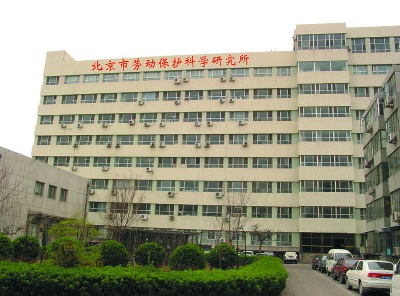
Beijing Municipal Institute of Labour Protection
No. 55 Taoranting Road, Beijing, 100054
The SafeChina project (http://www.safechina.risk-technologies.com) approaches its planned end in February 2013. The project main aim has been to build a sustainable education service in China offering the engineers and relevant professions the possibility to learn about the EU safety practices and regulation, and qualify as Environmental- and Safety engineers according to EU criteria, guidelines and practice. The project has been financed by DEG - Deutsche Investitions- und Entwicklungsgesellschaft mbH (German Investment and Development Agency) and realized by Steinbeis University Berlin (SHB) represented by Steinbeis Transfer Institute Advanced Risk Technologies and Beijing Municipal Institute of Labor Protection BMILP (www.bmilp.com), as the main strategic partner of Steinbeis in China.
The SafeChina project has created:
a) a curriculum of courses in Risk Engineering and Management adapted to the needs of Chinese beneficiaries,
b) a pattern for on-the-job training in EU/Germany and
c) a certifications scheme for Chinese professionals.
So far, the project has already achieved most of its goals, so far namely:
- performed a large-scale survey of Chinese needs in the area of industrial safety
- signed cooperation agreements with 17 Chinese partners
- signed cooperation agreements with INERIS, France and DEKRA, Germany
- prepared the curriculum of 12 full courses, fully translated in Chinese
- organized 14 instances of the above courses, attended by almost 500 participants
- certified over 400 professionals (passed various levels of exams)
- had already 14 short and 3 long on-the-job-trainings for Chinese professionals in Germany
- qualified 18 Chinese trainers in the framework of the train-the-trainer measures
- incorporated courses from the project in the curricula of one of the Chinese top-class universities, CUEB
- negotiates incorporation of the courses into one of the Chinese top universities, Tsinghua
- negotiates incorporation of the courses into the professional education in Chinese companies (Sinopec, Ping An, etc.)
- prepares an independent German-Chinese joint venture ("Steinbeis Advanced Risk Technologies Beijing") which will continue project activities after the official DEG-project end, i.e. after February 2013.
The project activities performed so far have been evaluated as "excellent" or "very good" by approx. 90% of all the Chinese stakeholders/participants in the project.
The event of January 12, 2013 was the occasion to award certificates to the Chinese professionals who have earned them as Risk Examiners and Risk Assessors, as well as Chinese trainers for the Safe-China courses (certified in the train-the-trainer program).
Draft Agenda
|
9:00 – 9:40
|
Welcome
|
|
9:00 – 9:20
|
Brief introduction of the speakers attending the ceremony and welcome address (Prof. Zhang Bin, General director of BMILP)
|
|
9:20 – 9:30
|
Welcome DEG officer (Ms. Veth [ytbc])
|
|
9:30 – 9:40
|
Welcome Steinbeis (Prof. Johann Löhn, President of Steinbeis University Berlin and former Government Commissioner for Technology Transfer in the State of Baden-Württemberg / Prof. Aleksandar Jovanovic, SafeChina Project Coordinator)
|
|
9:40 – 11:00
|
Presentations / Guest and keynote speeches
|
|
9:40 – 10:00
|
Presentation of the SafeChina project and its results / Presentation of the joint venture “Steinbeis Advanced Risk Technologies Beijing” (A. Jovanovic)
|
|
10:00 – 10:15
|
Keynote speech (Officer of Beijing Administration of Work Safety)
|
|
10:15 – 10:30
|
Keynote speech (Officer of State Administration of Foreign Experts Affairs)
|
|
10:30 – 11:00
|
Guest speech: Globalized Innovation and the Role of BRIC Countries (Prof. Manuel Heitor, former Secretary of State for Science, Technology and Higher Education in the Government of Portugal)
|
|
11:00 – 11:15
|
Short break
|
|
11:15 – 12:30
|
Guest and keynote speeches
|
|
11:15 – 11:30
|
Keynote speech (Officer from one department of State of Administration of Work Safety)
|
|
11:30 – 11:45
|
Keynote speech (Officer from another department of State of Administration of Work Safety)
|
|
11:45 – 12:15
|
Guest speech: Global education for global risks (Prof. Ortwin Renn, Member of the German Federal Government Ethics Committee on Energy Future)
|
|
12:15 – 12:30
|
Keynote speech (Mr. Ding Hui, President of Beijing Academy of Science and Technology)
|
|
12:35 – 13:00
|
Awarding the certificates
|
|
|
In two tracks (A-M and N-Z, handed out by Prof. Ding Hui, Prof. A. Jovanovic, DEG officer and Mrs. M. V. Florin [IRGC])
|
|
13:00
|
Closing announcement (Prof. Zhang Bin)
|
NOTES:
1. The event will be take place in conjunction with the IRGC International Conference in Beijing, on the topic of “From crisis management to risk governance” on 9-11 January 2013.
2. Possibility of establishing a cross-link to the EU project 2011/S 112-183587 will be explored.
About the hosting institution:
The Beijing Municipal Institute of Labor Protection was established in 1956 and is one of the first research institutes in China to carry out scientific research on security and environment. The institute has built many research institutes of professional techniques and test centers in the following three fields: urban security hygiene, work safety and labor protection and human living environment, which have laid solid foundation for a basic, applied and foresighted research. In the latest 50 years, it has achieved more than 500 scientific and technological results and won more than 200 awards for scientific and technological achievements and progress. It has stipulated more than 100 standards in labor protection and environment protection.
|
|
|
|
|
|
06 Dec
2012 |
Course in the framework of HELM project |
 |
A new course V-R36 Innovation Risk Management has been held in December, in San Sebastian, Spain.
|
Date: December 5, 2012
Venue: TECNALIA HEADQUARTERS, San Sebastian, Spain 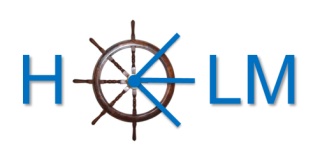
The course was be organized specifically for participants of the HELM project (High-frequency ELectro-Magnetic technologies for advanced processing of ceramic matrix composites and graphite expansion). You can find more information on the project's website.
Name:
Course V-R36
Innovation Risk Management
Course description:
The development of new products and technologies is a risky and uncertain process. The success of the new technology does not lie just in the invention part or in the generation of innovative ideas, but in the successful management of the innovation process from an idea to products and services in the market. The management of innovation is a rigorous process which includes a disciplined, stage-by-stage approval process combined with regular measurement of every critical factor, ranging from the capability of the product to reach the target characteristics to success in the market.
In order to help business grow and improve its competitiveness, an integrated design process to achieve a successful innovation is needed. The design process has to be supported by efficient knowledge management techniques and tools. The main purpose of innovation is to create value, and the method to reach this goal is to develop ideas, refine them into a useful form and bring them to market, where they will survive, achieve profitable sales and remain competitive. As described in the literature, innovation process models changed over time from simple linear models to more complex integrated models, however most of them involves a similar set of steps and stages. These are the following:
- Idea generation
- Concept development
- Concept evaluation and selection
- Development and implementation
- Management and control
- Launch to market
At the end of the course the participants have better understanding of
- Management process of innovation
- Concept of open innovation
- Understand the aspects of subcontracting in the innovation process
- Understand the aspects of involving the end-users in the innovation process
The course was lectured by Dr. Daniel Balos from STI Advanced Risk Technologies.
|
|
|
|
|
|
|
25 Nov
2012 |
Certification activities in China |
 |
Certification tracks and the SafeChina train-the-trainer exams were organized on November 15-24, 2012 in Beijing.

Certification for Risk Examiners and for Senior Risk Assessor both on the tracks Plant/Asset/Equipment and HSSE, as well as train-the-trainer oral exams have been organized between November 15 and 24, 2012 in the Beijing Municipal Institute of Labour Protection.
|
The certification process, per candidate, went as the following:
- Presentation of a project done relevant for the title Risk Examiner/Risk Assessor (the candidate has to prepare a presentation in MS Power Point, 15 minutes/candidate)
- Discussion about the project presented (15 minutes/candidate)
- Conclusion related to the presented work
In addition to the certification, oral exams were organized for the candidates who have passed the written exams in order to become a SafeChina trainer. The oral part of the train-the-trainer exam consisted of:
- Presentation of a selected part of the training material for the SafeChina course (the candidate has to prepare a presentation in MS Power Point, 15 minutes/candidate)
- Questions and answers related to the course topics (15 minutes/candidate)
- Conclusion related to the presented work
|
|
|
|
|
|
12 Nov
2012 |
SHB/SafeChina course 'Emerging Risks' concluded in Beijing |
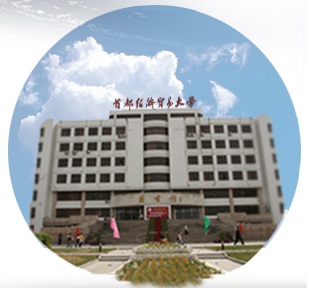 |
The Steinbeis University Berlin/SafeChina course Emerging Risks was held on November 10 - 11, 2012 in Beijing.
The course IV-R17 EmRISK: Emerging Risks has been taken place on November 10 - 11, 2012 at the Capital University of Economics and Business in Beijing.
The main objective of the course was to introduce the concept of "emerging risks" and explain to the students the issues of early recognition, classification and monitoring of emerging risks. In addition, the course presented frameworks, procedure and factors of emerging risks. 
Emerging Risks was dedicated to professionals and students in the field of risk engineering and management. The structure of the course units and tutoring style allowed to understand and adopt the main topics even to beginners in this field.
The participants of the course have particularly benefited from the lecturing done by Prof. Aleksandar Jovanovic from STI Advanced Risk Technologies/EU-VRi, who is leader of some of the most important research and development projects in the EU dedicated to emerging risks (e.g. iNTeg-Risk).
For further information, see the announcement of the course. |
|
|
|
|
|
24 Sep
2012 |
Course I-R02 PETRO |
 |
The SHB/iNTeg-Risk course I-R02 PETRO: Risk Analysis in Petrochemical Industry was held Sept. 24-28, 2012 in Stuttgart, Germany.
The 5-day course Risk Analysis in Petrochemical Industry has been successfully concluded. The course has taken place between September 24 and 28, 2012 in the Stuttgart Institute of Management and Technology (SIMT) in Stuttgart, Germany.
The course was open for students of the universities and employees of the companies participating in the project, as well as for the external participants.
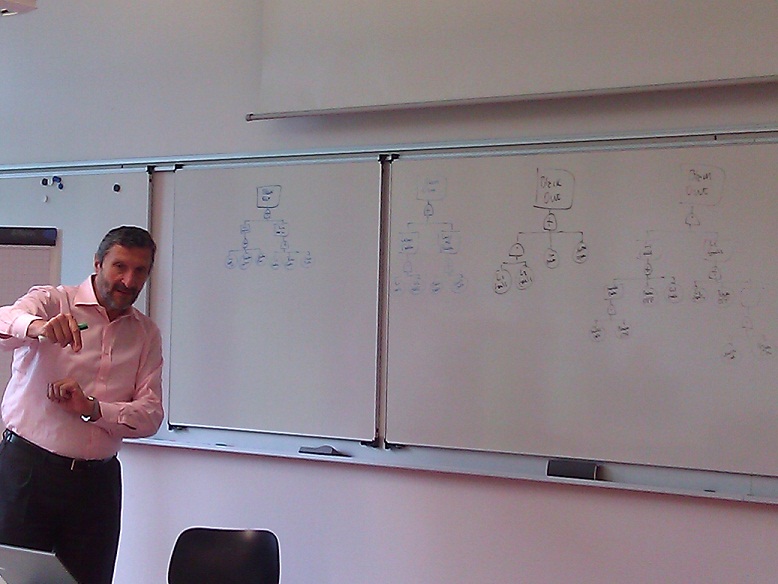
This course presented the current global and regional issues in petrochemical industries. During the course the participants learned about
- risk aspects and the methods for hazard identification applied in petrochemical industries,
- performing probability and consequences analysis and risk assessment, and
- health, safety and environment issues related to petrochemical industries.
Mr. Giovanni Uguccioni from D'Appolonia Spa (Italy) lectured 4 days, elaborating on current global and regional occurrences in the upstream, midstream, downstream and in petrochemical industries. The fifth day was spent by overviewing the course material and the students took an examination testing their acquired knowledge during the course.
|
|
|
|
|
|
|
12 Sep
2012 |
SafeChina course III-R12 OSHA |
 |
The course III-R12 OSHA: Occupational Safety and Health took place in Beijing on Sept. 12-16, 2012.
The course was held at the Beijing Capital University of Economics and Business, School of Safety and Environment Engineering in Sept. 12-16, 2012.
The course aimed to explain the EU regulations in the field of safety and health of workers at work. Main topics included
- general principles concerning the prevention of occupational risks,
- the protection of safety and health,
- the elimination of risk and accident factors,
- the informing, consultation, balanced participation in accordance with national laws and/or practices and training of workers and their representatives,
- as well as general guidelines for the implementation of these principles.
|
|
|
|
|
|
30 Jul
2012 |
Course on LCA |
 |
The course on Life Cycle Analysis and Assessment was successfully concluded in Stuttgart, Germany.
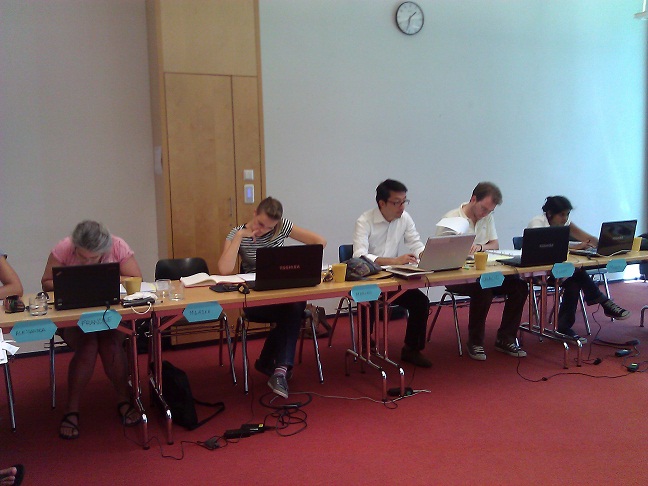
The course was open both for students of the universities participating in the project and for the external participants.
In the course the participants gained a comprehensive overview of the Life Cycle Assessment (LCA), Life Cycle Costing (LCC), International Reference Life Cycle Data System (ILCD) and European Reference Life Cycle Data System (ELCD).
The course is part of the European Master and Certification Program in Risk Engineering and Management, therefore as such, it enabled the participants to earn European ECTS credit points (see http://ec.europa.eu/education/lifelong-learning-policy/ects_en.htm).
|
Read more about the course! |
|
|
|
|
|
07 May
2012 |
Second event of Introduction to Risk Management |
 |
The second instance of the iNTeg-Risk course Introduction to Risk Management took place at the Stuttgart Institute of Management and Technology.
|
The course is part of the series of courses which all belong to joint effort of iNTeg-Risk project (represented by EU-VRi and other partners), University of Stuttgart (ZIRN) and Steinbeis University Berlin (STI Advanced Risk Technologies) to set a modern, modular and distributed model of education and certification in the area of Risk Engineering and Management with particular emphasis on the issue of emerging risks, in particular those related to new technologies.
The event took place on May 2-5, 2012 at the Stuttgart Institute of Management and Technology (SIMT). This specialist course was organized in conjunction with the 4th iNTeg-Risk Conference 2012.
Participants of the course had opportunity to extend their knowledge in the area of industrial safety, starting with different aspects of risks and terminology used in the field, with special focus on major accident prevention and related process safety risk assessment methodology. The participants came from different countries (Spain, Serbia, Germany, China, France, etc.) possessing different profiles (PhD, MSc and BSc students, professionals), thus allowing them to enjoy and profit from a real international environment during the course.
|
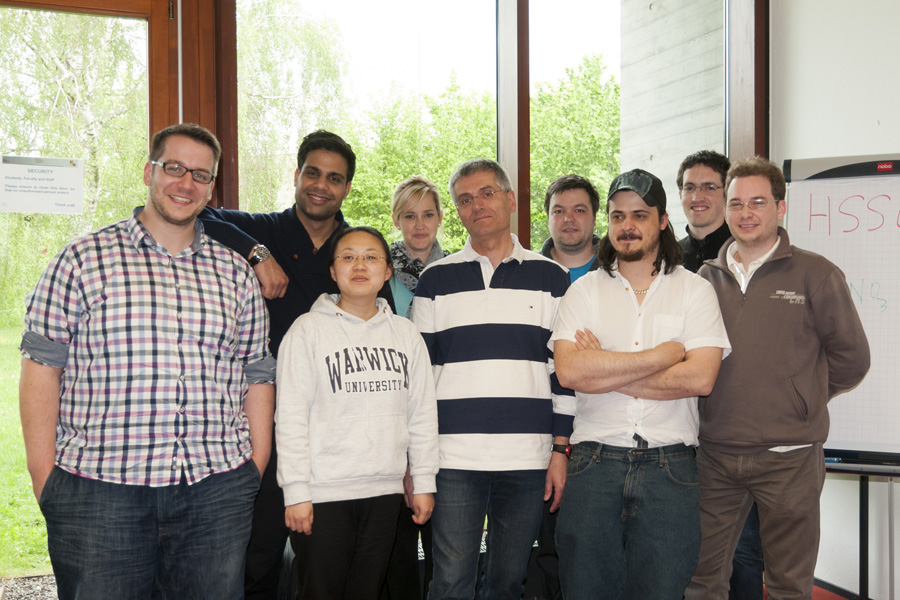
|
|
|
|
|
|
|
02 Apr
2012 |
RBI-PETRO was successfully concluded in Rotterdam |
 |
Risk Based Inspection - Petro was part of a course series organized through the joint effort of iNTeg-Risk project, University of Stuttgart and STI Advanced Risk Technologies.
 |
|
The iNTeg-Risk Course II-R4a "RBI-PETRO: Risk Based Inspection - Petro", which is part of the announced series of SHB/iNTeg-Risk courses, took place on March 27-30, 2012 in Rotterdam, the Netherlands.
During the 4-day course, 12 participants from Germany, Romania, China, Italy, Slovakia, the United Kingdom and Serbia had opportunity to learn more about Risk-Based Inspection (RBI) in general, its application in industry using different tools as well as to understand RBI technologies, procedures, and working processes in compliance with the main reference documents.
This series of courses is proudly organized through the joint effort of iNTeg-Risk project, University of Stuttgart (ZIRN) and Steinbeis University Berlin (STI Advanced Risk Technologies) to set a modern, modular and distributed model of education and certification in the area of Risk Engineering and Management with particular emphasis on the issue of emerging risks, especially those related to new technologies.
Furthermore, the course is a part of the European Master and Certification Program in Risk Engineering and Management.
|
|
|
|
|
|
|
17 Dec
2011 |
The course Introduction to Risk Management took place in Stuttgart |
 |
The course opened a series of courses to set a modern, modular and distributed model of education and certification in the area of Risk Engineering and Management.
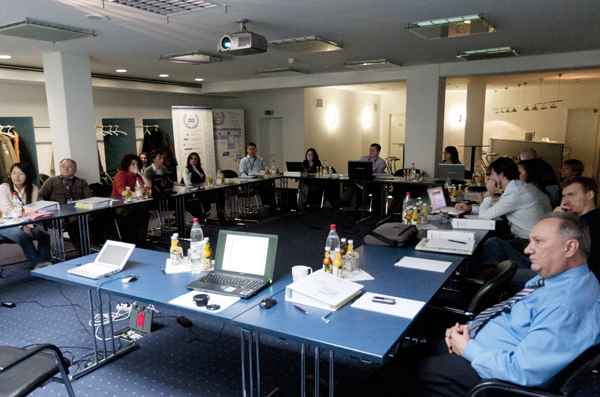 |
|
The course Introduction to Risk Management has taken place between December 12 and 16, 2011 in Stuttgart. It opened a series of courses which all belong to joint effort of iNTeg-Risk project (represented by EU-VRi and other partners), University of Stuttgart (ZIRN) and Steinbeis University Berlin (STI Advanced Risk Technologies) to set a modern, modular and distributed model of education and certification in the area of Risk Engineering and Management with particular emphasis on the issue of emerging risks, in particular those related to new technologies.
The course is also a part of SHB's European Master and Certification Program in Risk Engineering and Management.
During five days of the course, 20 participants from Germany, Italy, France, Greece, Serbia and United Arab Emirates had opportunity to learn and extended their knowledge on the main topics of risks related to the general use of the chemicals by a modern society and related industrial sectors (hazards, related risks, and due legislative safety measures considering accidental and chronic risks within life cycle of hazardous materials, major accidents prevention and
related process safety risk assessment methodology).
|
|
|
|
|
|
|
21 Sep
2011 |
The Certification Program of STI is approved! |
 |
Three certification modules in the area of Risk Engineering and Management which will be running at Steinbeis Transfer Institute Advanced Risk Technologies (STI) are approved on September 20, 2011.
Certification modules allow to gain the titles
- Risk Examiner in two separate tracks, HSSE and Plant/Asset/Equipment
- Senor Risk Assessor, also in two separate tracks, HSSE and Plant/Asset/Equipment
- Risk Governance specialist
The certification follows the pattern of
- one certification exam (written, test-based, oral examination only in exceptional cases) at the end of each respective course
- one additional certification oral exam for selected title at the end of a group of relevant courses.
The courses needed for this professional title are to be finished within 12 calendar months. |
|
|
|
|
|
09 Aug
2011 |
Aptitude test held on Friday, August 5, 2011 |
 |
Aptitude test for the candidates of the European Master Program in Risk Engineering and Management was held on Friday, August 5, 2011.
According to the study regulation, an aptitude test aims to check skills acquired within the scope of already completed university or training programs as well as skills acquired within the scope of continuing education measures and projects and it is mandatory for all applicants.
The aptitude test of STI Advanced Risk Technologies is a web based questionnaire consisting of questions of different types grouped in two main parts: verbal and numerical. The structure and type of questions allows to examine the knowledge and skills needed for the study defined in the Study and Examination Regulation of the European Master Program in Risk Engineering and Management.
All participants of the test would be notified about the test results on Friday, August 12, 2011. |
|
|
|
|
|
08 Aug
2011 |
Certification Program in preparation |
 |
Steinbeis Transfer Institute Advanced Risk Technologies (STI) has prepared three certification modules in the area of Risk Engineering and Management which are in the approval procedure.
Proposed certification modules allow to gain the titles
- Risk Examiner in two separate tracks, HSE and Equipment
- Senor Risk Assessor, also in two separate tracks, HSE and Equipment
- Risk Governance specialist
The certification follows the pattern of
-
one certification exam (written, test-based, oral examination only in exceptional cases) at the end of each respective course
- one additional certification oral exam for selected title at the end of a group of relevant courses.
The courses needed for this professional title are to be finished within 12 calendar months. |
|
|
|
|
|
|